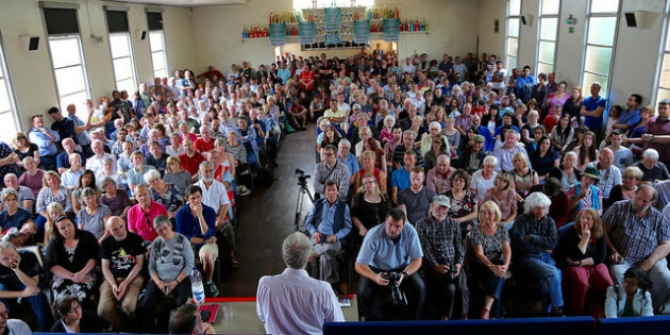
 The results of the European Parliament elections in the UK are out, and while various politicians have tried hard to frame the result as telling an ‘obvious’ story, it is probably because interpreting the outcome depends a lot on how you read the 2014 results, explain Michael Bruter and Sarah Harrison.
The results of the European Parliament elections in the UK are out, and while various politicians have tried hard to frame the result as telling an ‘obvious’ story, it is probably because interpreting the outcome depends a lot on how you read the 2014 results, explain Michael Bruter and Sarah Harrison.
The European Parliament election of 2019 is the story of a resounding success for the Remain camp – and of belated regrets over their divisions – and a ‘depends how you interpret things’ story for the Brexit camp. First, let’s look at the ‘narrow’ version where we assume that the Tory vote of 2014 was not a Eurosceptic vote (a pretty strange interpretation when you think Cameron promised an in/out referendum in 2013 and the Tories decided to leave the EPP in early 2014 to create their own Eurosceptic group in the European Parliament, both of which made the whole Eurosceptic planet ecstatic). We also leave the Labour vote out:
Eurosceptic vote, 2019 vs 2014: Brexit Party+UKIP+BNP+English Dem: 35.1% (+5.8)
Pro-European vote, 2019 vs 2014: LibDem+Green+ChUK+SNP+PC: 40.4% (+22.4)
Note that the BNP and English Democrats won nearly 2% of the vote election in 2014 on very Eurosceptic platforms so they should really be included in any comparison. Now, we should remember that merely a week ago, no opinion poll thought that the Remain parties’ vote could even be within touching distance of the hard Brexit camp, let alone 5 points ahead of it.
Second, let’s think of the Tory vote of 2014 as a predominantly Eurosceptic vote (for the reasons mentioned above) and the Labour vote as predominantly pro-European. Both include parties that have not been very clear on the EU question in European Parliament elections but it remains important to think of potential pools of voters in case either Tories or Labour revise/radicalise their positions on Brexit. With those enlarged definitions:
Eurosceptic vote, 2019 vs 2014: Brexit Party+UKIP+Con+BNP+English Dem: 44.0% (-7.5)
Pro-European vote, 2019 vs 2014: LibD+Green+ChUK+SNP+PC+Lab: 54.5% (+13.1)
Interestingly, choosing between the two interpretations only really matters in terms of deciding whether the Eurosceptic camp is up or down, and that basically depends on whether you separate ‘hard’ Eurosceptics from ‘soft’ Eurosceptics or not. However, under both interpretations: 1) the pro-EU camp performed significantly better than anti-EU forces in absolute terms; and 2) progressed a lot more significantly in the 5 years period.
Another way of saying the same is: the Eurosceptic camp in the UK has radicalised (with a leak from Tory ‘soft’ Euroscepticism to Brexit /UKIP ‘hard’ Euroscepticism) but also diminished overall, whilst the pro-European camp has radicalised (with a leak from Labour ‘soft’ pro-Europeanism to openly Remainer LibDem-Green-Change UK-SNP) but also strengthened very significantly.
Turnout questions
In that sense, whilst ERG leaders such as Mark Francois and Daniel Hannan read the result as a no-deal Brexit camp landslide, this is not quite that obvious, either in terms of the overall picture, or indeed in terms of where the Tories have lost their voters, which undoubtedly includes some leaks to the Remain camp as well as to the Brexit Party. The Brexit Party result remains an excellent one, but one should also remember that in the last week, some polls gave them on 38%. Instead, they are getting 31.5%. Conversely, the same polls gave about 15% to the Lib Dems, 8% to the Greens, 3% to the SNP, and 2% to Change UK. They respectively end around 20.5%, 12%, 4%, and 3.5% instead, all significantly higher.
In all likelihood, those differences are a consequence of two main phenomena: a) some voters changing their minds in the last few days towards the most pro-Remain parties (as mentioned elsewhere, we find that 20-30% of voters tend to make up/change their minds in the last week of an election, half of them on Election Day) and b) voters’ mobilisation which probably exceeded pollsters’ expectations. The turnout increase of about 3% seemed to come more from Remain than Leave voters.
In turn, this increase in turnout can again be interpreted in two opposite ways. First possible interpretation: this may be an artefact of Remainers being keener on partaking in this ‘symbolic’ election whilst traditional Tory voters stayed home to signal their frustration but may turn up when it matters. Under that interpretation, if there was a new referendum, the country’s Eurosceptic core may re-mobilise again as they did in 2016.
Second alternative interpretation: this mobilisation of Remainers is symptomatic. We mentioned in 2016 that the Remain vote was just as emotional as the Leave vote, but overwhelming expectations of a ‘Remain’ win probably made some voters complacent. If so, turnout may suggest that if there was a new Referendum, Remainers would mobilise significantly more than in 2016 whilst some of the angry voters who mobilised in 2016 but feel let down by the system might not.
What next?
The dominant interpretation has been that it is all very easy now: the Tories should push for no deal and Labour for a second referendum. Things may not be that simple. The Tories will push for a harder Brexit. But historically, when moderate right-wing parties trying to imitate a more radical discourse to ‘cut the grass under their [challengers’] feet’, they often fail abysmally. If the Tories embrace no deal, they may lose more from core moderates than they would gain in terms of disappointed radicals who may have lost trust in the Tories already anyway.
There may be a stronger case for Labour to try to take a clear pro-Remain stance because it would be an attempt to regain the centre ground where most elections are ultimately won. However, this would upset some of their traditional voters in industrial areas, and conversely, many of those who voted for Remain parties last week may not trust a Labour party which has been under so many confusing iterations of its Europe policy to date. Corbyn is seen as deeply Eurosceptic and Labour are probably seen as too confusing by many Remainers to be trusted.
How about the two winning sides of the night? A Brexit Party would be attractive to some but many will worry that voting for them would just hand out seats to Labour, so tactical voting mood may play against their interests as for UKIP in 2015, and many of their voters may still see them as an outlet to protest rather than govern. As for Remain parties, a Remain alliance may be an absolute necessity for those parties to have a chance to win. However, finding common ground on social and economic policies that would convince both Green and Change UK voters would be almost impossible, so to avoid alienating voters, a Remain Alliance may take the form of a ‘War Cabinet’ solely aiming to deliver a second referendum and campaigning for the UK to remain in the EU before offering the country a new General Election when it is time to return to ‘business as usual’. Moreover, the Remain camp has annoyed many voters with their divisions and some of the apparently contradictory messages on unity coming from Change UK leaders.
Most important of all, however, the result ends the myth of a line that could ‘unite the nation’. Both Tories and Labour promised a ‘unanimous’ way for three years. Be it when they stuck to general terms or when Ms May had to come up with specifics, those efforts have left public opinion very critical.
So we may have to accept that on Brexit, there is no middle way. Moreover, the split of the country – now slightly favouring the Remain camp – is not about cutting every category in half but rather about a division between fairly internally strong groups. The age split is significant, geographical splits are significant, and this creates an explosive potential for hostility and continued division which at this stage, no one has any idea how to tackle.
Thus, whoever wants to lead the country in a future General Election will need to find the answer to two questions. The first is how to adjudicate the current near-even split between those who think that we must absolutely leave the EU at any cost, and those who think that we must absolutely not. The second is how to handle the quasi-civil war that may well follow from whatever route it is that they propose. The Remain camp has had a great night and the Brexit party has managed to become the clear voice of the whole Eurosceptic camp, but neither them nor their competitors have a clear path on how they can deliver their preferred answer to the first question, and it seems that nobody in the country has any idea as to how to deal with the second.
____________________
Note: you can follow the work of the Electoral Psychology Observatory here.
 Michael Bruter is Professor of Political Science and European Politics in the Department of Government at the LSE, and Director of the Electoral Psychology Observatory.
Michael Bruter is Professor of Political Science and European Politics in the Department of Government at the LSE, and Director of the Electoral Psychology Observatory.
 Sarah Harrison is Assistant Professorial Research Fellow in Political Science in the Department of Government at the LSE, and Deputy Director of the Electoral Psychology Observatory.
Sarah Harrison is Assistant Professorial Research Fellow in Political Science in the Department of Government at the LSE, and Deputy Director of the Electoral Psychology Observatory.
All articles posted on this blog give the views of the author(s), and not the position of LSE British Politics and Policy, nor of the London School of Economics and Political Science.








Interesting perspective, however, I’m unconvinced that comparing voting behaviour in 2014 and 2019 is valid. Party positions have changed; at the time of the 2014 vote it seems fairer to consider both Labour and Conservative parties as being largely pro-EU – Cameron reluctantly agreed to an EU referendum because he believed the vote would end with a ‘remain’ result, putting the ‘EU question’ to bed, however, that’s not how it played out and he resigned as a result. Roll forward to 2019 and you can be forgiven for being a little confused about the Labour position on Brexit, however, formally, their policy is to respect the referendum result and leave the EU, as is that of the Conservative party. Based on party policy, it seems fair to argue that people who voted Labour or Conservative were voting for a party which formally supports Brexit. It might be argued that a Conservative vote was a ‘Brexit light’ vote and a Labour vote a ‘Brexit lighter-still’ vote. Of course, some of the overall vote has nothing to do with Brexit at-all. To just ignore the Labour and Conservative elements of the vote is erroneous.
Excellent analysis in my view.
If you look at results for the English regions, treating Lab and Con as ‘don’t know’, you get a small ‘Remain majority’. This seems significant because it is difficult to argue that Wales, Scotland and Northern Ireland are not also individually ‘Remain’ (by varying majorities.)